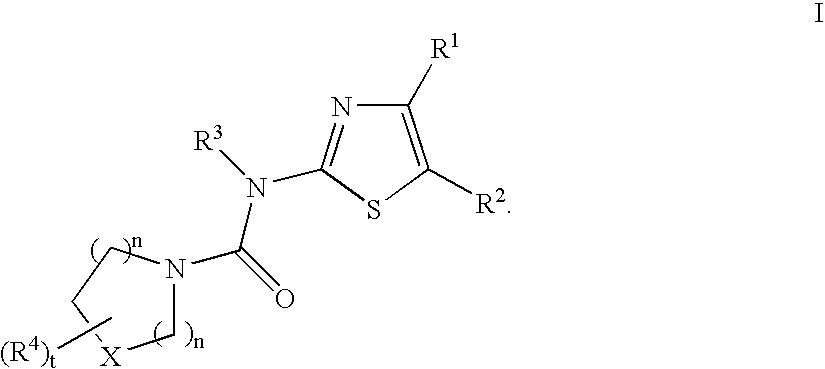Tyrosine kinase inhibitors
a kinase inhibitor and tyrosine technology, applied in the field of tyrosine kinase inhibitors, can solve the problems of visual degeneration, tumor growth is susceptible to antiangiogenic effects,
- Summary
- Abstract
- Description
- Claims
- Application Information
AI Technical Summary
Benefits of technology
Problems solved by technology
Method used
Image
Examples
example 1
[0424]
[0425]To a solution of 1.36 g (7.72 mmol) of 2-aminothiazole 1-1 in 24 mL of 7:1 THF / acetonitrile was added 1.56 g (7.72 mmol) of p-nitrophenylchloroformate, 1-2, followed by 781 μl (9.65 mmol) of pyridine. A thick yellow precipitate formed immediately. The resulting suspension was stirred vigorously at room temperature for 18 hours and then filtered. The yellow solid precipitate was washed several times with THF and dried in vacuo to provide 1-3.
example 2
[0426]
[0427]A solution of 100 mg (0.29 mmol) of 2-(4-nitrophenoxycarbonyl) amino-5-phenylthiazole 1-3, 44 μl (0.29 mmol) of 4-(2-pyridyl)piperazine 2-2, and 54 μl (0.31 mmol) of diisopropylethylamine, DIEA, in 1 mL anhydrous dimethylformamide, DMF, was stirred at 60° C. under a nitrogen atmosphere for 1 hour. The reaction was then concentrated in vacuo to an orange-yellow oil. The oil was dissolved in chloroform and washed 5× with concentrated aqueous NH4OH. The organic layer was dried over anhydrous Na2SO4, filtered, and concentrated in vacuo to an orange oil. The crude oil was purified by reversed phase preparatory LC, and the pure fractions concentrated and lyophilized to give the TFA salt of 2-3 as an amorphous white powder. H1 NMR (DMSO-d6): 3.62 (m, 4H), 3.69 (m, 4H), 6.81 (br t, 1H), 7.14 (br s, 1H), 7.28 (t, 1H), 7.41 (t, 2H), 7.57(d, 2H), 7.78 (m, 2H), 8.11 (dd, 1H). High Res. FAB MS: Theo. Mass=366.1383; measured mass=366.1399.
example 3
N-(5-phenylthiazol-2-yl)-N′-[4-(2-pyrimidinyl)piperazin-1-yl]urea (3)
[0428]
[0429]In a manner identical to that described above in Scheme 2, from 100 mg (0.29 mmol) of 2-(4-nitrophenoxycarbonyl)amino-5-phenylthiazole and 48 mg (0.29 mmol) of 4-(2-pyrimidinyl)piperazine was obtained the bis TFA salt of 3 as a fluffy white amorphous solid after lyophilization. H1 NMR (DMSO-d6): 3.61 (m, 4H), 3.72 (m, 4H), 6.70 (m, 1H), 7.45 (complex, 6H), 7.80 (s, 1H), 8.20 (m, 2H). High Res. FAB MS: Theo. Mass=367.1336; measured mass=267.1337.
PUM
 Login to View More
Login to View More Abstract
Description
Claims
Application Information
 Login to View More
Login to View More - R&D
- Intellectual Property
- Life Sciences
- Materials
- Tech Scout
- Unparalleled Data Quality
- Higher Quality Content
- 60% Fewer Hallucinations
Browse by: Latest US Patents, China's latest patents, Technical Efficacy Thesaurus, Application Domain, Technology Topic, Popular Technical Reports.
© 2025 PatSnap. All rights reserved.Legal|Privacy policy|Modern Slavery Act Transparency Statement|Sitemap|About US| Contact US: help@patsnap.com



